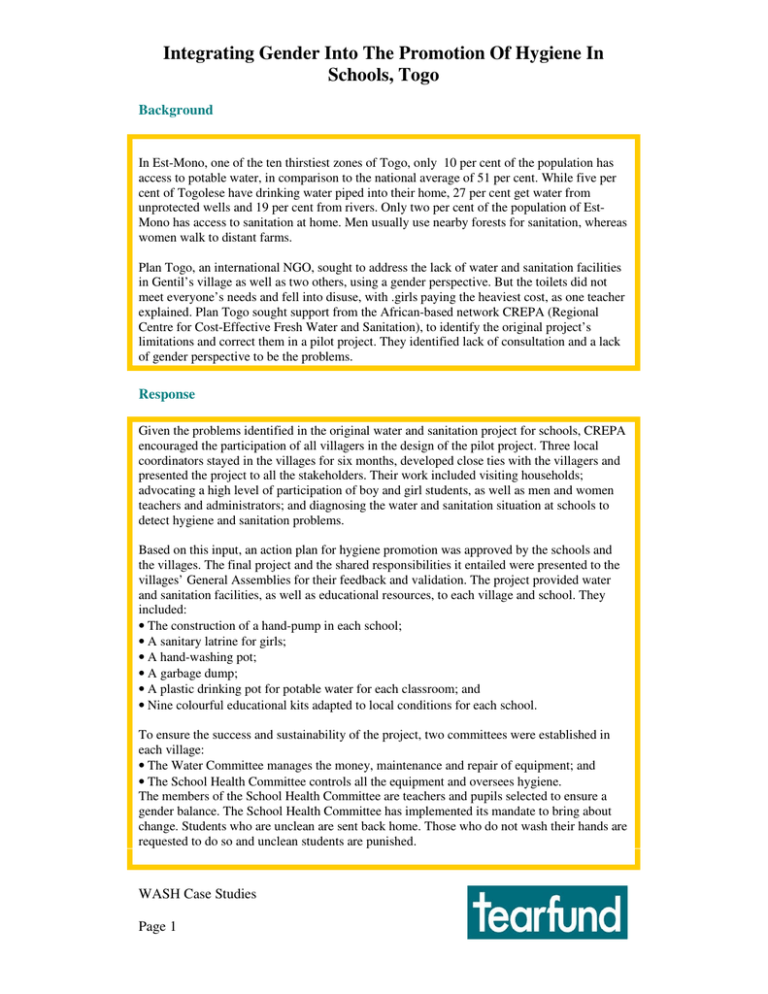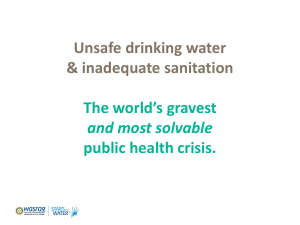Integrating Gender Into The Promotion Of Hygiene In Schools, Togo Background
advertisement

Integrating Gender Into The Promotion Of Hygiene In Schools, Togo Background In Est-Mono, one of the ten thirstiest zones of Togo, only 10 per cent of the population has access to potable water, in comparison to the national average of 51 per cent. While five per cent of Togolese have drinking water piped into their home, 27 per cent get water from unprotected wells and 19 per cent from rivers. Only two per cent of the population of EstMono has access to sanitation at home. Men usually use nearby forests for sanitation, whereas women walk to distant farms. Plan Togo, an international NGO, sought to address the lack of water and sanitation facilities in Gentil’s village as well as two others, using a gender perspective. But the toilets did not meet everyone’s needs and fell into disuse, with .girls paying the heaviest cost, as one teacher explained. Plan Togo sought support from the African-based network CREPA (Regional Centre for Cost-Effective Fresh Water and Sanitation), to identify the original project’s limitations and correct them in a pilot project. They identified lack of consultation and a lack of gender perspective to be the problems. Response Given the problems identified in the original water and sanitation project for schools, CREPA encouraged the participation of all villagers in the design of the pilot project. Three local coordinators stayed in the villages for six months, developed close ties with the villagers and presented the project to all the stakeholders. Their work included visiting households; advocating a high level of participation of boy and girl students, as well as men and women teachers and administrators; and diagnosing the water and sanitation situation at schools to detect hygiene and sanitation problems. Based on this input, an action plan for hygiene promotion was approved by the schools and the villages. The final project and the shared responsibilities it entailed were presented to the villages’ General Assemblies for their feedback and validation. The project provided water and sanitation facilities, as well as educational resources, to each village and school. They included: • The construction of a hand-pump in each school; • A sanitary latrine for girls; • A hand-washing pot; • A garbage dump; • A plastic drinking pot for potable water for each classroom; and • Nine colourful educational kits adapted to local conditions for each school. To ensure the success and sustainability of the project, two committees were established in each village: • The Water Committee manages the money, maintenance and repair of equipment; and • The School Health Committee controls all the equipment and oversees hygiene. The members of the School Health Committee are teachers and pupils selected to ensure a gender balance. The School Health Committee has implemented its mandate to bring about change. Students who are unclean are sent back home. Those who do not wash their hands are requested to do so and unclean students are punished. WASH Case Studies Page 1 Integrating Gender Into The Promotion Of Hygiene In Schools, Togo Impact Income Generation • By selling water considered to be sacred, not only are the schools now endowed with the status of nurturing life, they are also generating an income. The three Water Committees have already saved 182,000 F CFA (about US$ 330); and • Women now have more time to dedicate to income-generating activities. Impact on Health • Villagers now understand that the source of many diseases is unclean water and inappropriate sanitation; and • The health of the community, especially school-attending children, has improved and students are absent less often due to illness. Impact on Gender Equality • Many people can identify sources of gender imbalances; and • Women have been empowered and they want to organise public debates to address gender inequality issues. Impact on the Communities • Community members have changed their behaviour to adopt hygienic practices with water, food and waste; and • There are now stronger social ties among the four ethnic communities of Agan. Challenges • Poor sanitation habits and facilities; and • Lack of access to clean water. Key Factors for Success Addressing gender imbalances among students and ensuring the participation of the entire community has led to impacts far beyond the immediate results. For example, girls have increased their self-esteem and they are respected as leaders. Gender-balanced School Health committees control the equipment and oversee hygiene. Looking Ahead . Sustainability and Transferability CREPA and Plan Togo instilled in the communities the belief that gender mainstreaming contributes to the success of any project. CREPA and Plan Togo have signed contracts for similar projects in other areas of Togo. WASH Case Studies Page 2



